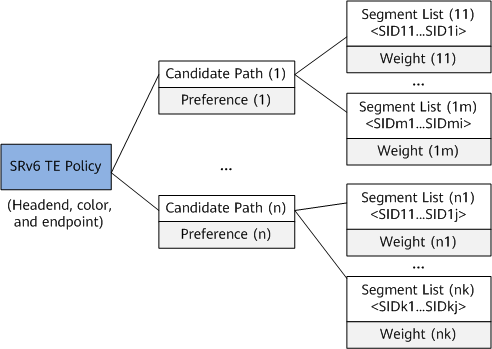SRv6 TE Policy
Definition
SRv6 TE Policy is a tunneling technology developed based on SRv6. An SRv6 TE Policy is a set of candidate paths consisting of one or more segment lists, that is, segment ID (SID) lists. Each SID list identifies an end-to-end path from the source to the destination, instructing a device to forward traffic through this path rather than through an IGP-computed shortest path. The header of a packet steered into an SRv6 TE Policy is augmented with an ordered list of segments associated with that SRv6 TE Policy. As such, other devices on the network can execute the instructions encapsulated into the list.
Headend: node where an SRv6 TE Policy originates.
Color: extended community attribute of an SRv6 TE Policy. A BGP route can recurse to an SRv6 TE Policy if they have the same color attribute.
Endpoint: destination address of an SRv6 TE Policy.
Color and endpoint information is added to an SRv6 TE Policy through configuration. The headend steers traffic into an SRv6 TE Policy whose color and endpoint attributes match the color value and next-hop address in the associated route, respectively. By defining an application-level network Service Level Agreement (SLA) policy, the color attribute allows network paths to be planned based on specific SLA requirements for services, realizing service value in a refined manner, and helping build new business models.
SRv6 TE Policy Model
The SRv6 TE Policy model is the same as the SR-MPLS TE Policy model, as shown in Figure 1. One SRv6 TE Policy may contain multiple candidate paths with the preference attribute. The valid candidate path with the highest preference functions as the primary path of the SRv6 TE Policy.
A candidate path can contain multiple segment lists, each of which carries a Weight attribute. Each segment list is an explicit SID stack that instructs a network device to forward packets, and multiple segment lists can work in load balancing mode.
